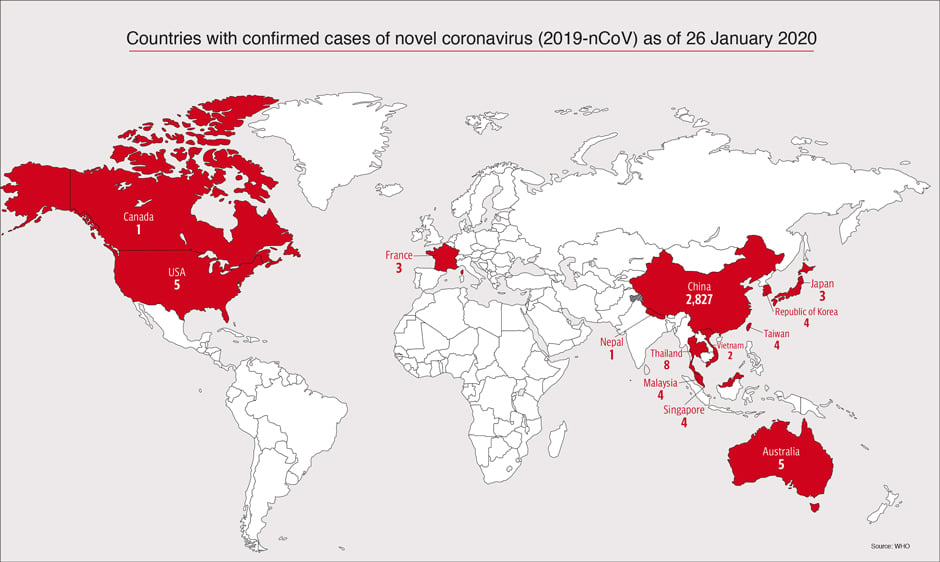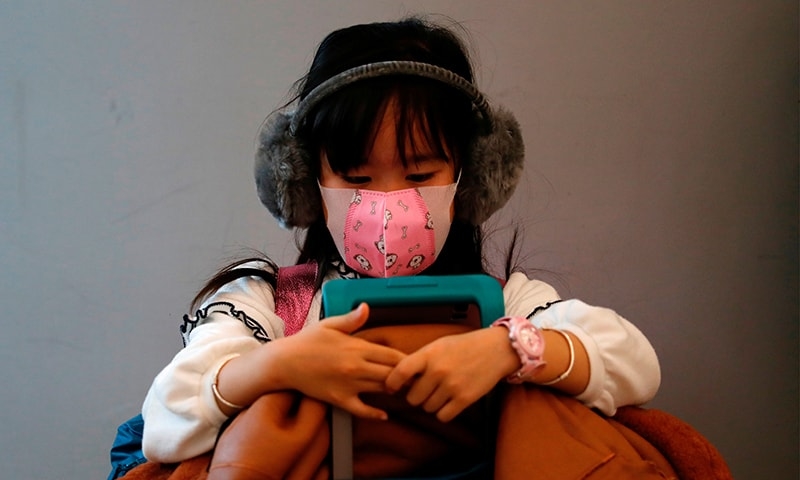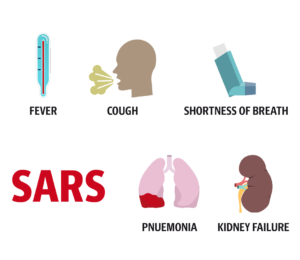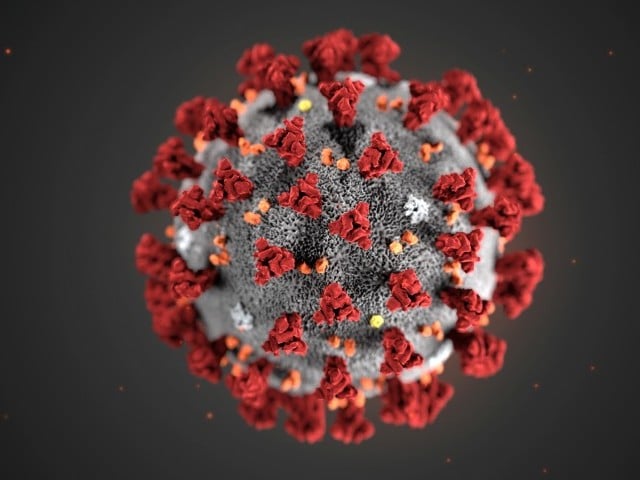Wuhan viral outbreak
Should we be scared?
The world appears to be in the grip of a new medical panic. Like the deadly SARS outbreak of the early 2000s, a mysterious new pandemic has emerged from China, our next-door neighbour.
Already, 81 people in the country have lost their lives to the strange new ‘coronavirus’ less than a month after initial outbreak in the city of Wuhan. With more than 2,800 cases confirmed thus far, there is widespread anxiety that the epidemic could wreak untold havoc before medical professionals come to grips with it.
But are these fears justified? Could it be that the public panic surrounding the viral outbreak is blowing things out of proportion? What do we actually know about this seemingly deadly contagion?

With a ‘c’, not ‘C’
Although its shorthand moniker would have one to think otherwise, ‘coronavirus’ is not exactly a proper name for the new disease. The term actually covers an entire group of viruses that cause illnesses in humans and other mammals, as well as birds.
Generally speaking, coronaviruses cause respiratory infections among humans which are more often than not mild and lethal only in rare cases. As a matter of fact, some strains of this group of viruses are believed to cause significant percentage of all common colds people experience.
On the more serious side, two of the rather deadly strains of coronaviruses already remain in popular memory – the SARS or the Severe Acute Respiratory Syndrome and the Middle East Respiratory Syndrome (MERS) which emerged in 2012.
The recent deadly strain that emerged in Wuhan has been given the name novel coronavirus (2019-nCoV) by the Chinese officials who identified it as a new disease. ‘Novel’, in this case, is a placeholder that means ‘newly discovered’ rather than an actual official designation. Informally, the new strain is also being called Wuhan pneumonia, Wuhan coronavirus or China coronavirus.

The breeding grounds
Coronaviruses have the tendency to be zoonotic, meaning they can be transmitted from other animal species to humans. The Wuhan strain is believed to have passed on to humans in that same manner.
The first reports of pneumonia-like symptoms caused by an unknown virus emerged in Wuhan just on the eve of the current year. The new strain was linked to a wholesale seafood market in the city that is known to sell ‘bushmeat’ – wild animals like game birds, bats, snakes and small mammals killed for culinary purposes.
Initial symptoms observed included fever, cough and respiratory issues like shortness of breath. In critical cases, the infection took the form of pneumonia, kidney failure and SARS before turning fatal.
According to various media reports, the Wuhan virus was first linked to a coronavirus strain commonly seen in snakes. However, in-depth analysis by a team at the Wuhan Institute for Virology determined 2019-nCoV is “96 per cent identical to a coronavirus found in bats”. Interestingly enough, bats were also determined to be the original source of the SARS outbreak.
Fear of the unknown
Chinese authorities were prompt in shutting down the Wuhan market for cleaning and inspection, doing so no more than a day later than initial reports. However, it appeared it was already too late by then as the new virus started spreading beyond the market area.
More bad news arrived on January 21 when the World Health Organisation confirmed the new disease was being transmitted between humans. China’s National Health Commission Minister Ma Xiaowei raised even more alarm on Sunday when he announced that the new virus, unlike SARS, could spread during its incubation period. What this means is that one may be spreading it before any symptoms manifest.
By Monday, the new disease had infected as many as 2,827 people with several more cases waiting to be confirmed. Although the vast majority of cases are still confined to China and only 44 have so far been confirmed outside it, the fact that the virus had already spread to 11 countries, including as far off as the US, Canada and France, has sent a wave of panic across the globe.

Premature anxiety?
Although 81 people have died due to Wuhan virus so far, medical experts from the top level of the WHO to on the ground in various countries have downplayed the scale of the emerging pandemic.
On Thursday, WHO Director General Dr Tedros Adhanom Ghebreyesus announced he would not be declaring a Public Health Emergency of International Concern (PHEIC). “Make no mistake, this is an emergency in China,” he underscored. “But it has not yet become a global health emergency… [although] it may yet become one.”
Since the announcement, the global health body has not changed its risk assessment for the outbreak.
Analysed statistically, the widespread panic surrounding the Wuhan virus suddenly appears premature. Of the more than 2,800 confirmed cases of the virus, only 25 per cent have been classified as ‘severe’, according to the WHO. At less than three per cent, the fatality rate of the new disease seems even more miniscule, especially when compared to SARS which had a 15 per cent chance of resulting in death.
Fears surrounding the disease seem especially blown out of proportion when the relatively small number of serious cases is examined more closely. “The individuals most adversely affected [by the Wuhan virus] have preexisting health complications such as heart disease, diabetes or cancer,” National Institute of Health (NIH) spokesperson Dr Mumtaz Ali Khan told The Express Tribune.
That said, this does not mean one should not be concerned about the new virus at all. According to health experts around the world, the biggest risk the Wuhan strain poses is that we don’t know anything about it at all. As such there is no saying how dangerous it can become, especially given the fact that there is no known cure for it.
According to a Reuters report, the strain has been classified as an ‘RNA virus’ rather than ‘DNA virus’. This means that the virus’s genetic material is composed of RNA rather than DNA, allowing it to merge with host DNA and mutating rapidly.
Should Pakistan be worried?
For now, Pakistan seems to have been spared by the Wuhan outbreak. Although four Chinese and one Pakistani nationals were admitted to hospitals in Multan and Lahore after showing symptoms of the new disease, NIH on Saturday confirmed there were as yet no confirmed cases.
“There is no need to panic,” stressed NIH spokesperson Dr Mumtaz while speaking to The Express Tribune. “Although there is a risk due to air travel between China and Pakistan, there is so far no case of the disease in the country,” he said.
Dr Tariq Nawaz, a health department official deputed at Karachi’s Quaid-e-Azam International Airport, confirmed that so far no cases of high-grade fever had been detected among travellers arriving in the country. “Even so, we have made arrangements at all airports. If someone is discovered to have high-grade fever, airport staff has set up a quarantine room equipped for taking blood samples which in turn, will be dispatched to NIH. Until the samples are cleared, the passenger will remain in quarantine,” he said.
“We have scanners that can identify if some passenger has a 100-degree Fahrenheit fever,” a Civil Aviation Authority spokesperson told The Express Tribune. “The scanners are operated by the federal health department staff,” he said.
According to the CAA spokesperson, the only risk with this set up emerged if arriving passengers try to bypass the scanners. He, as such, urged the travellers to cooperate with airport and health department staff to prevent any possibility of epidemic.
Meanwhile, NIH has advised all medical facilities and other concerned authorities in the country to investigate any individual that displays acute respiratory infections, fever and cough, or has travelled to China, Wuhan in particular, in the last 15 days. According to the advisory NIH has circulated, clinical samples of such patients should be referred to it promptly.
In Karachi, the Agha Khan University Hospital has also formulated a Wuhan coronavirus outbreak response service. “Tests for coronavirus are not available in Pakistan. AKUH is working with the Government of Pakistan and internal agencies as well as the World Health Organisation to address the situation,” AKUH said in a statement.

Personal precautions
According to health experts, in the absence of any anti-viral treatment for the new disease, individuals should exercise the same cautionary steps as they would to prevent any other contagious disease. They advised the public at large to refrain from sharing utensils without washing, washing hands frequently and consulting physicians immediately if they experience fever, cough or shortness of breath.
While preparing food, they advised people to cook meat and eggs thoroughly and use milk that had been pasteurised. They also urged people to avoid livestock and open air meat markets.
The experts strictly discouraged self-medication, especially the use of antibiotics without a doctor’s prescription.



